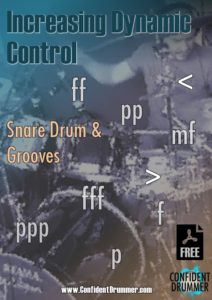As I always like to tell my students, music includes 3 elements: harmony/melody, rhythm and dynamics.
As drummers of course we are rhythm masters. Harmony and melody are not what we typically do, although it’s possible to tune the drums to specific pitches.
But we still have dynamics at our disposal: they basically determine the volume at which we play and they are a very powerful tool that many drummers overlook.
On the one hand we have the tendency to play everything as loud as possible, being the drums such a physical instrument and being most mainstream music very loud and dynamically flat.
On the other hand it’s hard to face the technical challenges that being able to play with dynamic control entails.
Yet, mastering this part of drumming is incredibly powerful in making what we play a lot more musical.
Music is a language, and wherever there’s communication, there’s also a story being told. This story can be more or less interesting based on what happens in it: tension and release, a plot twist, a surprise.
Like in a good movie or book, even in music mixing these ingredients wisely will contribute to the emotions being created. And the use of dynamics is very effective in this direction.
In this lesson we are going to study them in 3 steps:
– Theory.
– Preparatory Exercises with Snare and feet.
– Groove applications.
Here you can download the Pdf of the full lesson which includes all transcriptions and links to video demos:
If you’d like to watch the entire video demo click here.
THEORY:
Let’s start with a little theory.
Music notation uses symbols that traditionally are based on Italian words used to refer to a specific volume:
- ppp – as soft as possible
- pp – pianissimo – very soft
- p – piano – soft
- mp – mezzo piano – moderately soft
- mf – mezzo forte – moderately loud
- f – forte – loud
- ff – fortissimo – very loud
- fff – as loud as possible
- sf – sforzato – strained
- < – crescendo – gradually play louder
- > – decrescendo – gradually play softer
These dynamic levels can be studied with 3 approaches:
- One volume at the time.
- Changing volume with a sudden jump.
- Changing volume gradually (crescendo and decrescendo).
PREPARATORY EXERCISES:
To get used to play at these different dynamic levels, both conceptually and technically, we are going to practice a few specific exercises to get us familiar with the changes.
To begin with we are going to focus on one volume at the time.
Then we are going to move on to some very powerful crescendo and decrescendo exercises, in which we will learn to control even extreme dynamic levels and the possibility to gradually and smoothly change the volume at which we play.
The best way to start getting acquainted with these studies, is to play them with a simple alternating hand sticking on the Snare.
I have created a progression in 7 steps, going from ppp to fff. I’ve also included indications about the angle that can make it easier for us to play each level correctly.
When we feel comfortable with this first stage we can apply the same steps to the feet, so that we can gradually feel at ease including these ideas in everything we play.
In using the pedals we should try the whole dynamic range both heel down and heel up.
Let’s stay focused for a while on understanding how to manage the different levels and the type of control required.
Especially the crescendo and decrescendo, which require that we are very gradual in changing volume and also that we get to each specific dynamic in the right spot, with no sudden adjustments due to being too early or too late in our modulation.
GROOVE APPLICATIONS:
Then we can apply the same ideas and studies to beats and rhythms. Being able to control a wide dynamic range will radically expand our grooves.
As for anything else, the key to master this essential component of music is to go deep into the details involved, and that’s the point of these exercises.
In this case it’s not just about controlling the volume at which we play, but it’s also about choosing the right sound sources, surfaces and solutions.
Each element of the Drum Set offers a pretty wide choice of sounds, some of which are more suitable for achieving a certain dynamic level.
For instance, Rimshots clearly work better at louder volumes, while a Cross Stick it’s often a great choice when playing softer.
Likewise, playing heel up is best suited for louder dynamics and heel down for softer ones.
We’ll get started with a cool study in 4 levels (soft, moderately soft, loud, very loud) where we are going to play a groove with detailed instructions about the sound sources to use. We can then experiment with our own variations.
Then we move on to crescendos and decrescendos applied to beats, which are quite challenging, as we need to continually adjust not only the volume but also the sound choice that can easily let us get the desired volume in each moment.
Even though the transcribed exercises use just one groove, we can repeat them by following the same indications with anything we want to play.
Should we find it too hard, we can stick to basic beats for a while, so that we can more easily become familiar with the changes.
These kind of studies are designed to make us improve many areas of drumming simultaneously: technique, control, musicality.
That’s how to make the most of our practice time. And the best part of it is that these exercises are also extremely fun to play!
Check out these resources if you want to learn even more about this topic:
Unmusical vs Musical Drum Solo
1 Month Drum Challenge – Free Drum Course
‘Drum Technique Booster – The Masters’ Approach’
‘Hands & Mechanics’ – Altitude Drumming – Volume 2
‘Bass Drum & Feet’ – Altitude Drumming – Volume 3




















